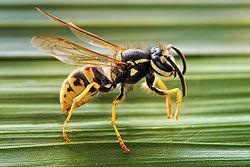
Back ذوات الخصر Arabic ذوات الخصر ARZ Apocrita AST Saplaqqarıncıqlılar Azerbaijani Висши ципокрили Bulgarian Apòcrits Catalan Štíhlopasí Czech Stilkhvepse Danish Taillenwespen German Apokrito Esperanto
| Apocrita Temporal range:
| |
|---|---|

| |
| Seleucus cuneiformis (Ichneumonidae) | |

| |
| Vespula germanica (Vespidae) | |
| Scientific classification | |
| Domain: | Eukaryota |
| Kingdom: | Animalia |
| Phylum: | Arthropoda |
| Class: | Insecta |
| Order: | Hymenoptera |
| Clade: | Unicalcarida |
| Suborder: | Apocrita Gerstaecker, 1867[1] |
| Subgroups | |
Apocrita is a suborder of insects in the order Hymenoptera. It includes wasps, bees, and ants, and consists of many families. It contains the most advanced hymenopterans and is distinguished from Symphyta by the narrow "waist" (petiole) formed between the first two segments of the actual abdomen; the first abdominal segment is fused to the thorax, and is called the propodeum. Therefore, it is general practice, when discussing the body of an apocritan in a technical sense, to refer to the mesosoma and metasoma (or gaster) rather than the "thorax" and "abdomen", respectively. The evolution of a constricted waist was an important adaption for the parasitoid lifestyle of the ancestral apocritan, allowing more maneuverability of the female's ovipositor.[2] The ovipositor either extends freely or is retracted, and may be developed into a stinger for both defense and paralyzing prey. Larvae are legless and blind, and either feed inside a host (plant or animal) or in a nest cell provisioned by their mothers.
Apocrita has historically been split into two groups, Parasitica and Aculeata. Aculeata is a clade whose name is in standard use. "Parasitica" is not a clade, as it is paraphyletic: the clade would contain the Aculeata. "Parasitica" is therefore a rankless grouping in many present classifications, if it appears at all.
Parasitica comprises the majority of hymenopteran insects, its members living as parasitoids.[3][4] Most species are small, with the ovipositor adapted for piercing. In some hosts, the parasitoids induce metamorphosis prematurely, and in others it is prolonged. There are even species that are hyperparasites, or parasitoids on other parasitoids.[5] The Parasitica lay their eggs inside or on another insect (egg, larva or pupa) and their larvae grow and develop within or on that host. The host is nearly always killed. Many parasitic hymenopterans are used as biological control agents to control pests, such as caterpillars, true bugs and hoppers, flies, and weevils.[6]
Aculeata is a monophyletic group that includes those species in which the female's ovipositor is modified into a stinger to inject venom. Groups within Aculeata include the familiar ants, bees, and various types of parasitic and predatory wasps; it also includes all of the social hymenopterans.[7] Among the nonparasitic and nonsocial Aculeata, larvae are fed with captured prey (typically alive and paralyzed) or may be fed pollen and nectar. The social Aculeata feed their young prey (paper wasps and hornets), or pollen and nectar (bees), or perhaps seeds, fungi, or nonviable eggs (ants).
- ^ Gerstaecker, C.E.A. (1867). "Ueber die Gattung Oxybelus Latr. und die bei Berlin vorkommenden Arten derselben". Zeitschrift für die Gesammten Naturwissenschaften (in German). 30 (7): 1–144.
- ^ Grimaldi, David; Engel, Michael S. (2005). Evolution of the Insects. Cambridge University Press. p. 414. ISBN 978-0-521-82149-0.
- ^ Cite error: The named reference
Peterswas invoked but never defined (see the help page). - ^ Heraty, John; Ronquist, Fredrik; Carpenter, James M.; Hawks, David; Schulmeister, Susanne; Dowling, Ashley P.; Murray, Debra; Munro, James; Wheeler, Ward C. (2011). "Evolution of the hymenopteran megaradiation". Molecular Phylogenetics and Evolution. 60 (1): 73–88. Bibcode:2011MolPE..60...73H. doi:10.1016/j.ympev.2011.04.003. PMID 21540117.
- ^ Sullivan, Daniel J. (2009). "Hyperparasitism". Encyclopedia of Insects. Elsevier. pp. 486–488. doi:10.1016/b978-0-12-374144-8.00138-7. ISBN 978-0-12-374144-8.
- ^ "Parasitoid Wasps (Hymenoptera)". University of Maryland. Archived from the original on 27 August 2016. Retrieved 6 June 2016.
- ^ Cite error: The named reference
BranstetterDanforth2017was invoked but never defined (see the help page).
© MMXXIII Rich X Search. We shall prevail. All rights reserved. Rich X Search